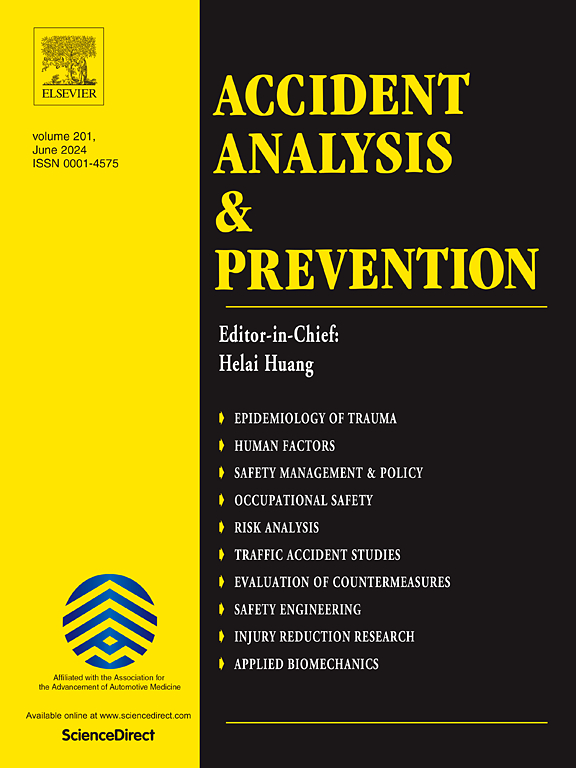Safety evaluation of protected bike Lane treatments at Intersections: A causal framework
IF 5.7
1区 工程技术
Q1 ERGONOMICS
引用次数: 0
Abstract
Intersections are a critical focus in bicycle safety research, as approximately one-thirds of bicycle-related crashes occur at these locations. Although protected bike lanes (PBL) at intersections, such as Lateral Shift and Bend-out treatments have been implemented, there is limited crash-based research on their safety performance. Furthermore, the prevailing use of before-after study designs for safety evaluation makes this approach susceptible to selection bias. To address this issue, this study proposes a causal inference framework that combines the advanced generalized causal random forest (GRF) and multimodal large language model (LLM). The LLM is used to extract contextual features from street view images, improving control over unobserved confounding bias. The GRF model is used for effectiveness evaluation by addressing selection bias through residual-based orthogonalization of treatment and outcome. The framework was applied to evaluate the safety impacts of Bend-out and Lateral Shift treatments at intersections. The results indicate that the proposed method outperforms both the baseline and comparative models across all metrics. The average treatment effect (ATE) of Lateral Shift treatments is 1.35 for total crashes and 1.21 for bicycle crashes, suggesting that these treatments tend to increase crashes. For Bend-out treatments, the ATE is −1.61 for total crashes and −0.55 for bicycle crashes, corresponding to a 32.2% reduction in total crashes and a 22.4% reduction in bicycle crashes. Analysis of road user behavior reveals that for Lateral Shift treatments, the low rate of drivers yielding to cyclists is a major issue, with only 30.7% of drivers yielding. To effectively implement Lateral Shift treatments, strengthening enforcement measures should be considered. Furthermore, riding in the wrong direction is a potential risk for both Lateral Shift and Bend-out treatments.
交叉口保护自行车道处理的安全性评价:一个因果框架
十字路口是自行车安全研究的重点,因为大约三分之一的自行车相关事故发生在这些地方。虽然在十字路口设置了保护自行车道(PBL),例如侧向移位和弯道处理,但基于碰撞的安全性能研究有限。此外,普遍使用的前后研究设计的安全性评估使这种方法容易受到选择偏差。为了解决这一问题,本研究提出了一种结合高级广义因果随机森林(GRF)和多模态大语言模型(LLM)的因果推理框架。LLM用于从街景图像中提取上下文特征,改善对未观察到的混淆偏差的控制。GRF模型用于有效性评估,通过基于残差的治疗和结果正正交来解决选择偏差。该框架被应用于评估在交叉路口的弯道和侧移处理的安全影响。结果表明,该方法在所有指标上都优于基线模型和比较模型。横向移位治疗的平均治疗效果(ATE)为1.35,对自行车碰撞为1.21,表明这些治疗倾向于增加碰撞。对于弯曲处理,总碰撞的ATE为- 1.61,自行车碰撞的ATE为- 0.55,对应于总碰撞减少32.2%,自行车碰撞减少22.4%。对道路使用者行为的分析表明,对于横向换挡处理,驾驶员对骑自行车者的低让行率是一个主要问题,只有30.7%的驾驶员让行。为了有效实施横向转移治疗,应考虑加强执法措施。此外,骑错方向对于侧移和外弯治疗都是潜在的风险。
本文章由计算机程序翻译,如有差异,请以英文原文为准。
求助全文
约1分钟内获得全文
求助全文
来源期刊

Accident; analysis and prevention
Multiple-
CiteScore
11.90
自引率
16.90%
发文量
264
审稿时长
48 days
期刊介绍:
Accident Analysis & Prevention provides wide coverage of the general areas relating to accidental injury and damage, including the pre-injury and immediate post-injury phases. Published papers deal with medical, legal, economic, educational, behavioral, theoretical or empirical aspects of transportation accidents, as well as with accidents at other sites. Selected topics within the scope of the Journal may include: studies of human, environmental and vehicular factors influencing the occurrence, type and severity of accidents and injury; the design, implementation and evaluation of countermeasures; biomechanics of impact and human tolerance limits to injury; modelling and statistical analysis of accident data; policy, planning and decision-making in safety.
 求助内容:
求助内容: 应助结果提醒方式:
应助结果提醒方式:


